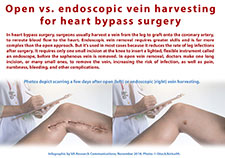Office of Research & Development |
 |


Dr. Marco Zenati is chief of thoracic and cardiovascular surgery at the VA Boston Healthcare System. (Photo by Mackenzie Adams)
November 28, 2018
By Mike Richman
VA Research Communications

Open vs. endoscopic vein harvesting for hearh bypass surgery (VA Research Communications; © iStock/kirisa99)
A new study finds that a form of vein removal used in heart bypass surgery—endoscopic vein harvesting—is just as safe as open vein harvesting when it’s performed by experts in vein removal.
The findings appeared in The New England Journal of Medicine on Nov. 11, 2018.
In a randomized trial of more than 1,100 patients, researchers with VA’s Cooperative Studies Program found no major difference in the rates of the two leg vein removal techniques to prevent cardiac events. The combined rate of all-cause death, heart attacks, and repeat vascularization, a procedure that creates a new or additional blood supply to a body part or organ, was 14 percent for endoscopic removal and 16 percent for open removal over nearly three years.
The VA study also confirmed what is already known about endoscopic vein removal: Its rates of post-surgical leg infections are lower than those of open vein removal.
Dr. Marco Zenati, the chief of thoracic and cardiovascular surgery at the VA Boston Healthcare System, led the study, which is known as the REGROUP trial. He says the findings in a sense “redeemed” endoscopic vein removal, the safety of which has been called into question by clinicians in the past.
The difference this time around is that the REGROUP trial “crucially only included expert vein harvesters,” says Zenati, who is also a professor of surgery at Harvard University.
"My conclusion is that endoscopic is the way to go when it’s in the hands of experienced medical personnel."
“My conclusion is that endoscopic is the way to go when it’s in the hands of experienced medical personnel,” he says. “Endoscopic vein removal has a steep learning curve, and inexperienced harvesters may damage the conduit, leading to early graft failure and heart problems. If the harvester is inexperienced, open harvesting is likely to be preferred.”
The REGROUP trial included harvesters with at least 100 cases of endoscopic vein removal and less than a five percent use of open harvesting over the previous two years. That’s an excellent level of experience, Zenati says. Vein harvesters are essentially heart surgeons.

VA Study Documents Health Risks for Burn Pit Exposures

VA center training the next generation of researchers in blood clots and inflammation

Could cholesterol medicine reduce dementia risk in seniors?

Million Veteran Program director speaks at international forum
Both endoscopic and open vein harvesting call for removal of the greater saphenous vein in the leg for use in coronary artery bypass grafting, the most common type of open-heart surgery. The saphenous vein is the conduit most often used in heart bypass surgery because of its ease of access.
Endoscopic vein removal requires greater skills and is much more complex than the open vein approach. It’s also used in more than 90 percent of cases because it reduces the rate of leg infections following surgery. That’s because the procedure requires only one small incision at the knee to insert a lighted, flexible instrument called an endoscope, before the saphenous vein is removed. In open vein removal, doctors make one long incision, or many small ones, to remove the vein, increasing the risk of infection, as well as pain, numbness, bleeding, and other complications.
However, evidence of the long-term cardiac safety of endoscopic vein removal has been limited by small trials with short follow-up.
Cardiovascular disease, the No. 1 killer of Americans, is the leading cause of hospitalization in VA. The disease is associated with ailments that often affect Veterans, including diabetes, PTSD, and spinal cord injuries.
One of the most common forms of heart disease, coronary artery disease is a blockage of the vessels that supply blood to the heart. It’s a key reason people have bypass surgery in hopes of avoiding a heart attack or death. In heart bypass surgery, grafts using the saphenous vein route the blood around an artery lesion to restore blood flow and oxygen to the heart. But those grafts may develop atherosclerosis, a hardening and narrowing of the arteries, which then necessitates a repeat procedure, or revascularization.
The REGROUP trial came nearly a decade after a large study led by Duke University investigators called the PREVENT IV trial questioned the safety of endoscopic vein removal. The 2009 study, which appeared in the New England Journal of Medicine, found over three years that a group of patients who underwent endoscopic vein removal had higher rates of death, heart attack, or repeat revascularization than an open vein group.
Zenati and his colleagues assume the vein harvesters in PREVENT IV were inexperienced because he says the study leaders set no threshold for minimum experience.
Zenati’s study included 1,150 patients undergoing heart-bypass surgery at 16 VA medical centers. The patients were randomized evenly into two groups, one that had endoscopic vein removal and the other open vein removal. In addition to cardiac events, the scientists looked at the rate of leg infections.
Zenati says the results increase the likelihood that endoscopic vein removal will continue to be used in more than 90 percent of heart bypass surgeries in the United States. The study may also influence a change in practice in Europe, where endoscopic removal is used in less than 20 percent of heart bypass procedures, he notes.
“Open and endoscopic harvesting are the same in terms of safety,” he says. “But fewer leg- wound complications tip the scale toward endoscopic.”
In Zenati’s view, it’s unlikely there will be more randomized trials to better understand the long-term safety of endoscopic removal.
“That’s because our study is likely definitive,” he says.
VA Research Currents archives || Sign up for VA Research updates